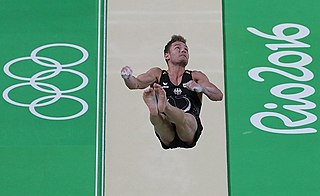
Gymnastics is a sport that includes physical exercises requiring balance, strength, flexibility, agility, coordination,dedication and endurance. The movements involved in gymnastics contribute to the development of the arms, legs, shoulders, back, chest, and abdominal muscle groups. Gymnastics evolved from exercises used by the ancient Greeks that included skills for mounting and dismounting a horse, and from circus performance skills.
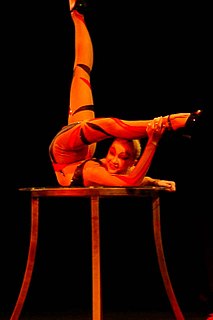
Contortion is a performance art in which performers called contortionists showcase their skills of extreme physical flexibility. Contortion acts often accompany acrobatics, circus acts, street performers and other live performing arts. Contortion acts are typically performed in front of a live audience. An act will showcase one or more artists performing a choreographed set of moves or poses, often to music, which require extreme flexibility. The physical flexibility required to perform such acts greatly exceeds that of the general population. It is the dramatic feats of seemingly inhuman flexibility that captivate audiences.
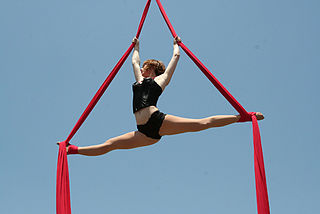
Acrobatics is the performance of human feats of balance, agility, and motor coordination. Acrobatic skills are used in performing arts, sporting events, and martial arts. Extensive use of acrobatic skills are most often performed in acro dance, circus, and gymnastics, and to a lesser extent in other athletic activities including ballet, slacklining and diving. Although acrobatics is most commonly associated with human body performance, the term is used to describe other types of performance, such as aerobatics.

A trapeze is a short horizontal bar hung by ropes or metal straps from a ceiling support. It is an aerial apparatus commonly found in circus performances. Trapeze acts may be static, spinning, swinging or flying, and may be performed solo, double, triple or as a group act.

Fire performance is a group of performance arts or skills that involve the manipulation of fire. Fire performance typically involves equipment or other objects made with one or more wicks which are designed to sustain a large enough flame to create a visual effect.
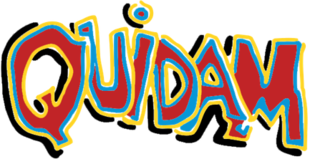
Quidam was the ninth stage show produced by Cirque du Soleil. It premiered in April 1996 and has been watched by millions of spectators around the world. Quidam originated as a big-top show in Montreal and was converted into an arena format beginning with its 2010 tour in North America. It then changed back to the Big Top for a 3-month run in Seoul, South Korea before returning to an arena show for its tour to Oceania. The show performed for the final time in Christchurch, New Zealand on February 26, 2016.
Corteo is a Cirque du Soleil touring production that premiered in Montreal, Quebec, Canada on April 21, 2005.

The aerial hoop is a circular steel apparatus suspended from the ceiling, on which circus artists may perform aerial acrobatics. It can be used static, spinning, or swinging. Tricks that can be performed include the Candlestick, Bird's Nest and Crescent Moon
The National Centre for Circus Arts is a professional circus school in the Hoxton area of Shoreditch in London that offers one of the UK's only university degree programmes in circus. It is a leading centre for contemporary circus training. It supports the professional development of circus performers and circus companies and runs youth and adult evening classes every week. It also runs the London Youth Circus.

Impalement arts are a type of performing art in which a performer plays the role of human target for a fellow performer who demonstrates accuracy skills in disciplines such as knife throwing and archery. Impalement is actually what the performers endeavor to avoid – the thrower or marksman aims near the target rather than at him or her. The objective is to land the throw or shot as close as possible to the assistant's body without causing injury.
The Wheel of Death, in the context of the impalement arts, is a classic moving target stunt sometimes performed by knife throwers. The thrower's assistant or target girl is secured to a large, generally circular, target board that is free to spin about its centre point. As the target rotates the thrower must execute a series of rapid, consistent and carefully timed throws to land knives on the segments of the wheel not covered by the assistant's body.
Hooping is the manipulation of and artistic movement or dancing with a hoop. Hoops can be made of metal, wood, or plastic. Hooping combines technical moves and tricks with freestyle or technical dancing. Hooping can be practiced to or performed with music. In contrast to the classic toy hula hoop, modern hoopers use heavier and larger diameter hoops, and frequently rotate the hoop around parts of the body other than the waist, including the hips, chest, neck, shoulders, thighs, knees, arms, hands, thumbs, feet, and toes. The hoop can also be manipulated and rotated off the body as well. Modern hooping has been influenced by art forms such as rhythmic gymnastics, hip-hop, freestyle dance, fire performance, twirling, poi, and other dance and movement forms.

The Drill of Death is a large-scale stage illusion in which a performer appears to be impaled on a giant drill. It was created by magician André Kole and illusion designer Ken Whitaker for magician Melinda Saxe. It was one of Saxe's signature tricks and featured as a highlight in her various First Lady of Magic shows.
This is a general glossary of the terms used in the sport of gymnastics.

The Cyr wheel is an acrobatic apparatus that consists of a single large ring made of aluminum or steel with a diameter approximately 10 to 15 cm taller than the performer. The performer stands inside the Cyr wheel and grasps its rim, causing it to roll and spin gyroscopically while performing acrobatic moves in and around the rotating wheel. The apparatus and its movement vocabulary have some similarities with the German wheel, but whereas the German wheel consists of two large rings linked together by horizontal crossbars and has handles for the performer to hold onto, the modern Cyr wheel consists of a single ring and has no handles. The Cyr wheel takes its name from Daniel Cyr, who revived its popularity, utilising it as a circus apparatus at the end of the 20th century.
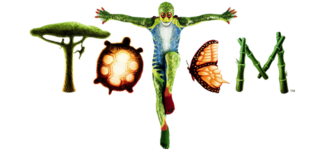
Totem is a touring show by Cirque du Soleil that premiered in Montréal on April 22, 2010. It was written and directed by previous collaborator Robert Lepage (Kà). Cirque du Soleil describes Totem's theme as the evolution of humanity from its primordial, amphibian state toward the aspiration of flight, taking inspiration from many of humanity's founding myths. The show was awarded the 2013 New York Drama Desk Award for Unique Theatrical Experience.

Zarkana was a Cirque du Soleil stage production written and directed by François Girard. It began as a touring show in 2011 and was converted to a resident show in Las Vegas in late 2012. It premiered at Radio City Music Hall in New York City on June 29, 2011, and later toured to the State Kremlin Palace in Moscow and the Madrid Arena in Madrid.
Hand to hand acrobatics is a type of performance in which an acrobatic base and flyer balance on top of each other in either a gymnastic or acrobatic medium. It combines strength, agility, flexibility, and balance. For it to be considered hand to hand acrobatics, the top performer (flyer) must be making physical contact only with the base's hands, with the flyer's hands keeping them balanced. Positions the top can perform in this style of acrobatics are straddles, handstands, pikes, press to handstand, one arm handstands, planches, flags, and many others. Hand to hand acrobatics can also include dynamic catches and throws that either begin with a throw from a hand to hand position or end in a catch in the hand to hand position.













